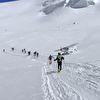Everest, the crowd and the race to nowhere

 1 / 4
1 / 4 Simone Moro
Simone Moro
Between the 25th and 26th of May 150 people reached the summit of Everest. Only a few days before, 4 people had died below the same peak after a sudden storm struck the mountain. But nothing stopped this slow multitude march towards the highest point on earth. So, just like a bill that reaches its due date, the time has come once again to talk about the "phenomenon" of a crowded Everest. Like a crowded seaside resort in the height of summer, this mountain was literally overflowing with alpinists, mountaineers and not, Guinness record breakers, those who buy and sell summits, pros and inexperienced climbers, champion mountaineers, tourists, Sherpa... A circus of "give it all you want" which for years, every season without fail, fuels stories already written and told.
Stories of caravans of people marching upwards, heedless of the dangers that this crowding may cause. Stories both absurd and painful. Sometimes even ignoble. Loaded with those who died from exhaustion. Of men abandoned to their fate. Oxygen bottles used as an impossible remedy to counterbalance the unpreparedness of the many. Of announced tragedies . Of stupidity. Of lies. Of rescues and acts of solidarity which, so isolated yet so obvious in everyday life, as to seem absolutely heroic. And then stories of Sherpa used as high altitude waiters. Men, always Sherpa, who risk and lose their lives while forging the way for the sahib-climber-consumers of the third millennium. To serve and also to save them. Theirs have long been real stories of exploitation, "white deaths" at the highest of altitudes.
In short, this year there was talk once again about Everest turned into an incredibly amusement park, to use the words of Simone Moro. But also talk about that Everest which is no longer a mountain for mountaineers, as Romano Benet explained some years ago. But if this is a poor copy of something that has already been written, why does it continue to repeat itself, rather, why does it seem to become increasingly laden and "normal"? There can be numerous answers. Some were contained, in a sort of warning bell, in Krakauer's best seller Into Thin Air, which brought to attention of the general public the terrible epic on the roof of the roof of the world. That was back in 1996 and, since then, after those 8 deaths on Everest, many things were said. And much criticism was launched against the dangers of what many define as the consumerism of the mountain. Indeed, it all seemed to be attributed to the phenomenon of "commercial expeditions", that selling of the summit with all-inclusive rates for everybody, regardless of their ability. Although this was and is certainly a part of the problem, the suspicion lingers that this doesn't explain it all.
It does not explain, for example, why the phenomenon is on the rise despite the fact that many agencies have repeatedly demonstrated professionalism and preparation. Such as the agency led by Bruce Russel who, this year, aborted his expedition due to the objective dangers - including overcrowding - on the route. The latest from the other side of the pond is that many customers now want a refund... As if to say: perhaps part of the problem stems from the demand. In the mountaineering "culture", but also in the culture , of those who aspire to reach the roof of the world. Why do so many believe that all that's needed is to dosh out big dollars to secure Everest's summit? The advertising used by commercial expeditions certainly isn't sufficient to explain this phenomenon. And it certainly cannot all boil down to the draw of the world's highest mountain
As time passes, this phenomenon persists and expands. And as this grows, the meaning to this all seems elusive, seems to escape from simple explanations. Stating what the mountaineering world has repeated for years seems useless, indeed counterproductive. Reinhold Messner, for example, continues to talk about "pistes", referring in particular to the normal routes up Everest in particular and, in general, to the 8000ers. Downplaying the difficulties - although Messner does this in reference to what is defined as cutting-edge alpinism - seems not to increase risk awareness and the great difficulties connected with ascending Everest. Even if helped and served by Sherpa while using copious amounts of supplementary oxygen. Indeed it may even have a boomerang effect.
Instead, what should be stressed clearly is that climbing that mountain, ascending at that altitude, never was and never will be for everyone. And that that dream, the beautiful dream of reaching the highest peak, cannot be acquired. Because, like all dreams, it needs to be earned. Through hard work, preparation, dedication, sacrifice, while knowing full-well that it might also remain unattainable. One needs to be able to take a step back. Know when to stop. Understand that the true value lies mainly in the road towards, in the experience. And that we cannot devalue everything (all values, all ethics if you will) for the sake of an ephemeral, intangible glory or personal gain.
But Everest, at this point, perhaps has nothing to do with this. Perhaps it's because of these difficult times we're experiencing, and why we're witnessing them. It has to do with the awareness that man cannot achieve anything. That money and the illusion of what if might be able to buy isn't the only value. One mustn't continue to believe that Nature and the Earth can continue to be looted for the good of the world markets and GDP. Yes, that very Nature which, as fate decided, was benevolent during the last few days up on Everest, while that endless snake of men wound its way towards the top. All that was needed was one of those storms, often unexpected, and everything would once again have transformed into a tragedy. Luckily this didn't occur and we are very happy and also relieved. However, what remains is the immense bitterness for this queue. For those 4 deaths which will soon be forgotten. It hurts to think that this mad rush will continue, relentlessly. To nowhere...
Vinicio Stefanello



 Copia link
Copia link
























